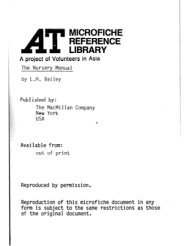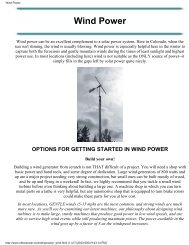, “. ~ .- ,_ . * -I ' REFERENCE- .? -BBRARY p ;A ~~~ect;~~~vol ...
, “. ~ .- ,_ . * -I ' REFERENCE- .? -BBRARY p ;A ~~~ect;~~~vol ...
, “. ~ .- ,_ . * -I ' REFERENCE- .? -BBRARY p ;A ~~~ect;~~~vol ...
Create successful ePaper yourself
Turn your PDF publications into a flip-book with our unique Google optimized e-Paper software.
Introduction<br />
line or kerosene generators to charge their<br />
batteries, and the addition of wind power<br />
helped reduce fuel costs and wear-and-tear<br />
on generators. Out of all this backyard activity<br />
grew the pre-REA windcharger industry.<br />
Some half-millron wind systems once existed<br />
in the United Statesalone, but it’s not clear<br />
‘from hrstorical records whether this number<br />
includes the water pumpers along with the<br />
windchargers.<br />
Farmers used wind-generated electricity<br />
to power a radio. one or two lights for reading.<br />
eventually an electric refrigerator. or a<br />
wronger washing r nachine, and not much<br />
else. Electric irons f or pressing clothes, electric<br />
shavers. and ( ther gadgets built to run<br />
on direct current appeared, but most of<br />
these proved un r ealistic uses for windgenerated<br />
electric power. In fact, they may<br />
have contributed to the demise of wind electrrcrty<br />
when rural electrification began. Electric<br />
appliances performed much better<br />
on an REA line, which wasn’t subject to<br />
dead batteries. <strong>“</strong>Lets go over tothe Joneses.<br />
Pa. They got one of them new power lines.<br />
Maybell says her refrigerator don’t defrost<br />
no more!”<br />
Rural electrrfrcatron put most windchargers<br />
out of busrness. In the Midwest you can<br />
drive for mrles on an empty dir-t road. following<br />
a long electric power line to only one. or<br />
perhaps two. homes at the end of the road.<br />
Leave one road and follow the next. It’s the<br />
same story REA lines were Installed and<br />
Iwind generators came down. Sears catalogs<br />
touted all the marvelous gadgets one could<br />
buy and plug into the newly installed power<br />
line.<br />
Electric stoves, hot curlers, electric air<br />
conditioners, two or more TV sets-these<br />
aren’t very realistic loads to place on a wind-<br />
charged battery. However, wind power can<br />
contribute to the operation of these devices,<br />
especially if grid power is already doing<br />
part of the job. With such cogeneration<br />
(wind power used together with grid power)<br />
the more wind power available, the’less grid<br />
power needed.<br />
In another application, wind power can’<br />
provide heat for warming households, dairy<br />
barn hot water, or just about anything else<br />
for which heat is used as long as the h&at is<br />
not needed in a carefully controlled amo‘+n.t.<br />
This wind heating concept is called. the<br />
wind furnace, and it’s one of our most useful<br />
applications of wind power. Wind furnaces’<br />
can use wind-generated electricity to pro-<br />
duce the heat, or they can convert mechani-<br />
cal power into heat directly.<br />
Energy Budgets<br />
Wind machine design ‘must begin with a<br />
realistic assessment of energy needs and<br />
available wind resources. When confronted<br />
by Inexperienced people observing my wind<br />
machine. I’m most often asked, <strong>“</strong>Will it power<br />
my house?” Taking this question to its most<br />
J<br />
outrageous extreme. I’m often tempted to<br />
reply,, <strong>“</strong>Just how fast would you like your<br />
house to go?” But usually. I just ask, <strong>“</strong>How<br />
much power do you need at your house?” _ stalled by the REA<br />
.<br />
.<br />
<strong>“</strong>, ., ;<br />
A windcharger of the 1930’s. Hundreds of thousands<br />
of mldwestefn Arnerlcan farm homes were<br />
;)owe!ed by the wind before ut~l~t’y lines were In-




